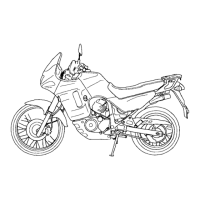BATTERY/CHARGING SYSTEM
17-7
CHARGING SYSTEM INSPECTION
CURRENT LEAKAGE TEST
Remove the right side cover (page 2-4).
With the ignition switch turned OFF, disconnect the
negative (–) cable from the battery.
Connect the ammeter (+) probe to the negative (–)
cable and the ammeter (–) probe to the battery (–)
terminal.
With the ignition switch turned OFF, check for cur-
rent leakage.
• When measuring current using a tester, set it to a
high range, and then bring the range down to an
appropriate level. Current flow higher than the
range selected may blow the fuse in the tester.
• While measuring current, do not turn the ignition
switch ON. A sudden surge of current may blow
the fuse in the tester.
If current leakage exceeds the specified value, a
shorted circuit is the probable cause.
Locate the short by disconnecting connections one
by one and measuring the current.
CHARGING VOLTAGE INSPECTION
Make sure the battery is in good condition before
performing this test.
Start the engine and warm it up to the operating
temperature; then stop the engine.
Remove the right side cover (page 2-4).
Connect the multimeter between the positive and
negative terminals of the battery.
To prevent a short, make absolutely certain which
are the positive and negative terminals or cable.
With the headlight on high beam, restart the engine.
Measure the voltage on the multimeter when the
engine runs at 5,000 min
-1
(rpm).
SPECIFIED CURRENT LEAKAGE: 2 mA maximum
NEGATIVE (–) CABLE: (+) PROBE
NEGATIVE (–) TERMINAL: (–) PROBE
Do not disconnect
the battery or any
cable in the
charging system
without first
switching off the
ignition switch.
Failure to follow this
precaution can
damage the tester
or electrical
components.
STANDARD:
Measured BV < Measured CV < 15.5 V
· BV = Battery Voltage (page 17-6)
· CV = Charging Voltage

